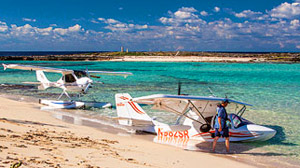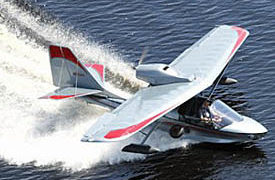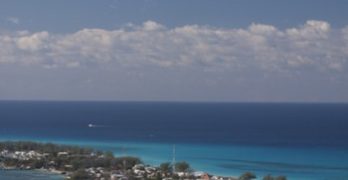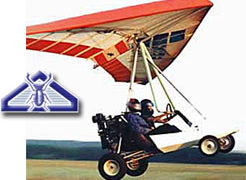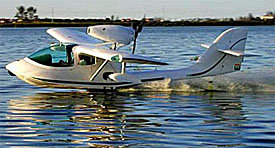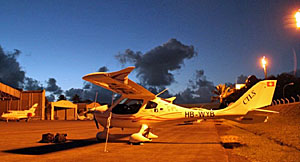“Isn’t it just a niche market?,” asked a reader in a recent email. The query came after he read about a flurry of new seaplanes and the writer wondered if it could be worth all the investment pouring in to these projects. Development progress in this particular sector-within-a-sector (LSA seaplanes) seems to be far outdistancing development in other parts of the aviation world. So, are efforts to develop increasingly sophisticated LSA seaplanes economically justifiable? It’s a worthy question. Another answer: “Well, why not?” An amphibious LSA seaplane can land on water or land, could fly as fast or nearly as fast as a land plane. They can look cleaner with gear that disappears. They already have another 110 pounds to work with (though admittedly much of that is needed simply to achieve an amphib seaplane and even that is not enough for all manufacturers). If you want an LSA, why not one that’s more versatile?
Search Results for : atol
Not finding exactly what you expected? Try our advanced search option.
Select a manufacturer to go straight to all our content about that manufacturer.
Select an aircraft model to go straight to all our content about that model.
Seaplane Tsunami — Water-Borne Flying Fun
Once upon a time, in the early days of Light-Sport Aircraft, way back in 2006 and 2007, new LSA models were being introduced at the torrid pace of two, three, even four per month. Aviation had no prior design outpouring to compare. The rate of development had to slow — such a pace is not sustainable — and it did. Yet the young industry continued on to the astonishing sum of 131 models and it ain’t over yet. Meanwhile, though, a new tsunami is building within the LSA sector. I’ve written about a wave a new seaplanes and as summer 2013 approaches, a tour of the many choices may help guide interest of seaplane enthusiasts.
Current Seaplanes (distinguished from float-equipped land planes *) include FAA-accepted SLSA models: Mermaid, SeaMax, SeaRey, and Freedom. At present all are being offered and have some measure of U.S.
LSA Fun Foreign and Domestic
Back from a busy, weather-challenging (for photography) trip to the Bahamas, I stopped by to visit Dan Johnson and his soul mate Randee at their Spruce Creek air park digs near Daytona Beach, Florida. If you haven’t had the pleasure, visit Spruce Creek sometime to see how cool an air park can be. Hundreds and hundreds of homes, condos, hangars and “planeports,” even on-site business and a restaurant make this a wonderful aviation destination. It’s my fourth visit over the years and always a pleasure … as it is to visit with Dan and Randee.
This time I got to meet Dan’s partner-in-aviation Brian Boucher, a long time, big-jet professional pilot and one of four owners of the new Flight Design CTLSi I flew for Plane & Pilot magazine up in CT at Tom Peghiny’s US HQ just before it left for Spruce Creek. The opportunity came up for Dan to join the partnership and the numbers made sense, so now the Johnsons are part owners of that lovely fuel-injected CTLSi.
Russian “Beetle” Four-Wheeled Weight Shift
News from Russian sport aircraft producers is rare. Though the old USSR had a vast military aircraft complex that hasn’t translated to recreation aircraft the way it did in the formerly Soviet Czech Republic, where many of our LSA originate. However, that doesn’t mean efforts are absent. We’ve seen some uptake of LSA (like Pipistrel) into Russia but here I’ll portray an unusual Russian development. It may not find a U.S. market but I find it intriguing.
The designer, Anatoly Geralevich Szukov, calls his work the result of “garage aviation,” a surprisingly American term (think: Apple computer coming from Steve Jobs’ garage) for a very different project… from Russia. Instead of meaning a source of innovation, however, Szukov uses the garage term because his development allows people to store their aircraft in a normal garage. Szukov’s U.S.-based contact didn’t provide an English name for Szukov’s company (though if you read Russian you might deduce it).
LSA Seaplane Invasion …Can It Happen?
What’s going on out in the marketplace? More than any time since the launch of Light-Sport Aircraft in 2004, I have not observed such a frenzy of activity for a particular niche, this time for LSA seaplanes. Next season, in 2013, we could see no less than nine entries; three brand new and that count does not include any LSA equipped with floats, possibly adding several more. Yet some major potholes appear in the runway… or perhaps that should be waves sloshing over the bow.
One entry is a return of a LSA seaplane previously seen in the USA as the Freedom S100 (SLSA List #44) yet can it reenter the market without a full FAA audit? See Update at end. A new agency directive with the catchy name 8130.2G CHG 1 may require a FAA visit to Spain but who knows when that might occur, given the likelihood of an FAA budget cut through the political process known as sequestration, part of the so-called “fiscal cliff” the mainstream media drones on about endlessly.
LSA News Wrap — Rotax-Icon-Tecnam-More
Another busy week finished a very active August that has seen high readership… for which we sincerely thank you. Following are some brief news stories in the LSA space.
*** ROTAX “EMERGENCY AD?” Aviation media was all over the Rotax “Emergency AD” story, but is that entirely accurate? Aren’t LSA subject to manufacturer-issued SBs or Service Bulletins rather than Airworthiness Directives, which are normally issued by FAA for certified aircraft? Well, “yes,” said Rotax expert Phil Lockwood. He explained that the matter in question — some fuel lines that need to be replaced — was a result of a vendor change bringing some incorrect components. “Rotax issued a Service Bulletin last spring on this subject,” Phil added. The so-called “emergency AD” was triggered by an EASA issuance primarily for certified Rotax engines in Europe. Rotax BRP is a very careful company that is quick to correct problems and this was something of delayed reaction that again appears to show the certified world may not respond as quickly as the LSA sector.
They’re Home! Twin Solo Round-the-World Flights
Two Swiss pilots embarked on a round-the-world flight on April 30 and 51 days later they are back home in Switzerland. Yannick Bovier, 37, and Francisco Agullo, 41, created an expedition they call “Azimut 270” to celebrate 100 years of aviation in Switzerland, a country known for its natural beauty and for being bankers to the world. *** The dynamic duo returned safely on Saturday, June 19 after crossing two oceans, confronting suspicious government officials for country overflight permission, paying high landing and permit fees, battling fatigue and loneliness, performing routine maintenance that comes with so many hours logged, plus having to watch what foods they consumed during flight legs that several times started before dawn and ended after dark. (On-board bathrooms have yet to be installed in the first Light-Sport Aircraft making such biological necessities a real challenge). *** Starting on the last day of April, the duo leaped the Atlantic to Brazil by May 8 and then crossed the Caribbean to Miami, Florida, USA by May 13.
Product Lines – June 1991
St. Paul, MINN — With this June issue of Hang Gliding, "Product Lines" enters its 13th year of continuous run, thanks to loyal readers and the many of you who have alerted me to news in our sport. Other columns have begun and eventually their authors retired, but this chatty column keeps flying. Yes, diver fans, there really is enough interesting hang gliding news to keep going for some 125 monthly columns (in the early days of "PL" in Whole Air, the column came out bimonthly). Thanks to all of you. Now, on with the show… ••• Aerotowing! It’s real and real fun, and before long, real obtainable. While ATOL and other suppliers like TLS have provided us with superlative platform towing hardware and the technology to tow to great heights and long distances, many like myself have felt that aerotowing was the superior way to launch. Except that it’s only superior if the tug is up to the special demand of towing hang gliders.
Product Lines – January 1991
ST PAUL, MINN — Aloha! With his wife, Toni, Jerry Forburger completed his deal with airpark developer, Bill Fulton. The ATOL’ers have begun employment with Sport Aviation Hawaii and will begin by offering tandem intros to the islands’ millions of visitors. Tourists and students will get to soar some the smoothest lift in the world (“…after about 700 feet, lift seems to fill the whole valley.”), viewing spectacular scenery: incredibly steep green mountains, cascading waterfalls, and an uncommercialized tropical landscape. Few outsiders have ever set foot in the Kaaawa Valley ’til Fulton made his deal with the Kualoa Ranch family. Says Fulton, “We’ve had visits by several experts. Many think Sport Aviation could be one of the world’s largest schools.” To qualify for such a title, the business will count an expected 20,000 Japanese tourists a year flying on the world’s longest Hang Glider Simulator®. ||| Fulton orchestrated hang gliding participation in the Navy Hydrofest ’90, a fund raiser (needed after budget cuts) to help the Navy provide recreation for the thousands of sailors who regularly dock and restock at Pearl Harbor.
Product Lines – November 1990
ST. PAUL, MINN — In announcing minor refinements on the Sensor E model, Seedwings begins to reveal their accord with the Austrian distributor now representing the brand in Europe. ||| First, the E model has control bar hardware which permits the glider to be laid down flat without disassembly of the wings. This has long been a requirement of the European pilot. Next, the Sensor has a speedbar, which they’ve subjected to 1,000 pounds without seeing deformation. It has only a 2.5 inch offset, reducing flex and allowing better in-bag storage. ||| Bob Trampenau’s design will now use streamlined down tubes offered by Finsterwalder, one of Europe’s up and coming manufacturers (who recently acquired the Charly company, a big manufacturer of safety and accessory products in Germany). Seedwings has enabled the airfoil downtubes to fit all models of the Sensor line. ||| While many pilots are attracted to the airfoil downtubes, some pilots raise a question.


